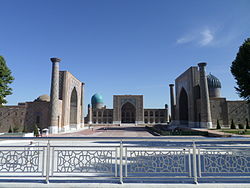Architecture of Central Asia
The Architecture of Central Asia, which is generally considered as comprising Kazakhstan, Kyrgyzstan, Mongolia, Tajikistan, Turkmenistan, and Uzbekistan has been influenced by a diverse array of architectural traditions such as Russian architecture during the eras of tsarist and Soviet rule, Islamic architecture which came earlier, Persian architecture, and Chinese architecture.
Timurid architecture

Timurid architecture is the pinnacle of Islamic art in Central Asia. Spectacular and stately edifices erected by Timur and his successors in Samarkand and Herat helped to disseminate the influence of the Ilkhanid school of art in India, thus giving rise to the celebrated Moghol school of architecture. Timurid architecture started with the sanctuary of Ahmed Yasawi in present-day Kazakhstan and culminated in Timur's mausoleum Gur-e Amir in Samarkand. The style is largely derived from Persian architecture. Axial symmetry is a characteristic of all major Timurid structures, notably the Shah-e Zendah in Samarkand and the mosque of Gowhar Shad in Meshed. Double domes of various shapes abound, and the outsides are perfused with brilliant colors.
Persian architecture
Due to the long tradition of Persian influence in Central Asia, many significant buildings in the Persian tradition are located there. Examples of these include the Minaret of Jam.
See also
References
